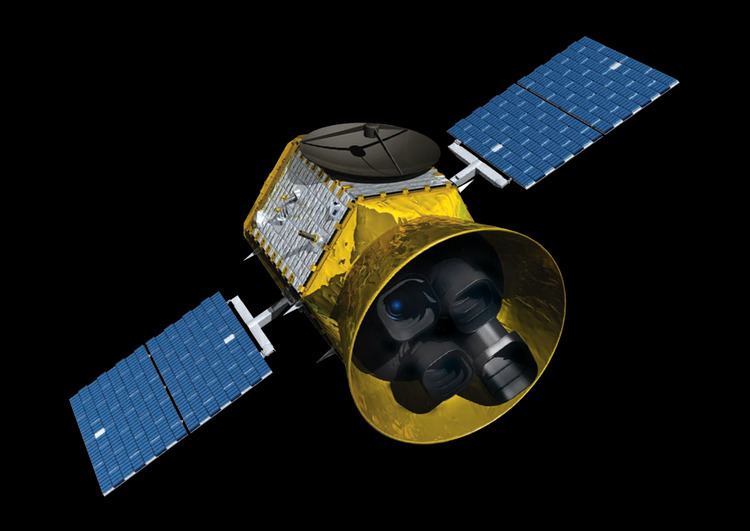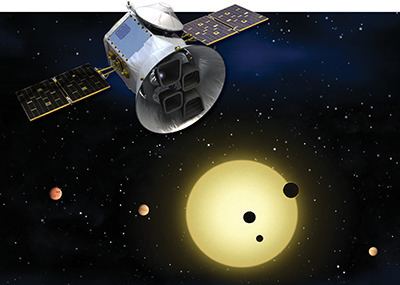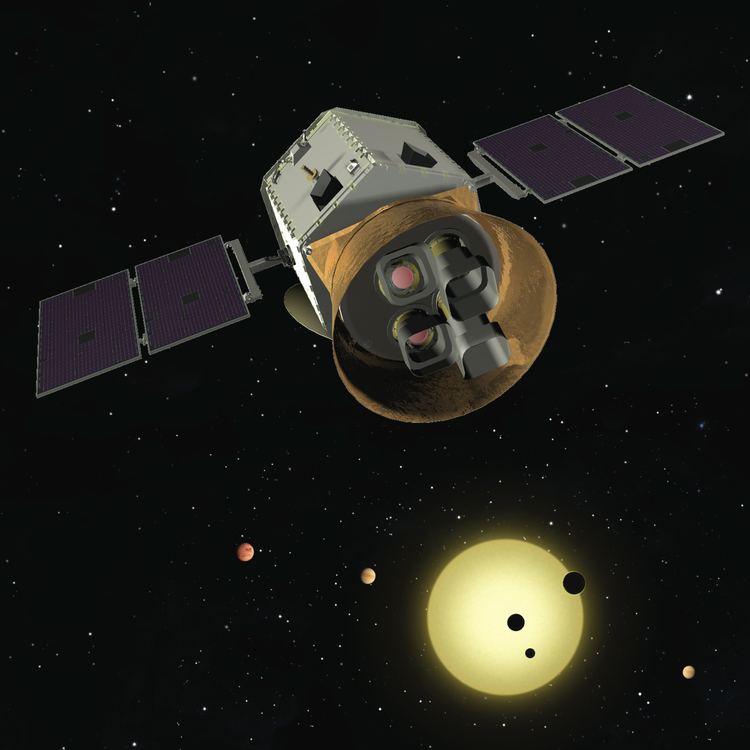Mission type Space observatory Mission duration Planned: 2 years Period 14 days Launch mass 350 kg | Bus LEOStar-2 | |
 | ||
Dimensions 3.7 × 1.2 × 1.5 m (12.1 × 3.9 × 4.9 ft) Launch date NET 20 March 2018; (NLT June 2018) Similar | ||
Transiting exoplanet survey satellite tess
The Transiting Exoplanet Survey Satellite (TESS) is a planned space telescope for NASA's Explorers program, designed to search for exoplanets using the transit method. It is planned for launch in March 2018.
Contents
- Transiting exoplanet survey satellite tess
- The transiting exoplanet survey satellite tess
- History
- Mission overview
- Orbital dynamics
- Scientific objectives
- Spacecraft
- Launch
- Science instrument
- Stable light source for tests
- Asteroseismology
- References

The primary mission objective for TESS is to survey the brightest stars near the Earth for transiting exoplanets over a two-year period. The TESS project will use an array of wide-field cameras to perform an all-sky survey. With TESS, it will be possible to study the mass, size, density and orbit of a large cohort of small planets, including a sample of rocky worlds in the habitable zones of their host stars. TESS will provide prime targets for further characterization by the James Webb Space Telescope, as well as other large ground-based and space-based telescopes of the future.
Previous sky surveys with ground-based telescopes have mainly detected giant exoplanets. In contrast, TESS will examine a large number of small planets around the very brightest stars in the sky. TESS will record the nearest and brightest main sequence stars hosting transiting exoplanets, which are the most favorable targets for detailed investigations.

Led by the Massachusetts Institute of Technology with seed funding from Google, TESS was one of 11 proposals selected for NASA funding in September 2011, down from the original 42 submitted in February of that year. On April 5, 2013, it was announced that TESS, along with the Neutron Star Interior Composition Explorer (NICER), had been selected for launch.

The transiting exoplanet survey satellite tess
History
The genesis of TESS began as early as 2006, when a design was developed from private funding by individuals, Google, and The Kavli Foundation. In 2008, MIT proposed that TESS become a full NASA mission and submitted it for the Small Explorer program at Goddard Space Flight Center, but it was not selected. It was resubmitted in 2010 as an Explorers program mission, and was approved in 2013 as a Medium Explorer mission.
The transit technique has been a successful way of studying and discovering exoplanets, and when launched TESS will join a growing fleet of telescopes studying in this area.
Mission overview
TESS is designed to carry out the first spaceborne all-sky transiting exoplanet survey. It is equipped with four wide-angle telescopes and associated charge-coupled device (CCD) detectors. Science data will be transmitted to Earth every two weeks. Full-frame images with an effective exposure time of two hours will be transmitted as well, enabling scientists to search for unexpected, transient phenomena, such as the optical counterparts to gamma-ray bursts.
Orbital dynamics
In order to obtain unobstructed imagery of both the northern and southern hemispheres of the sky, TESS will utilize a 2:1 lunar resonant orbit called P/2, an orbit that has never been used before. The spacecraft's 373,000 km (232,000 mi) apogee is timed to keep the craft away from the Moon, which acts as a destabilizing agent. This highly elliptical orbit should remain stable for decades, and will keep TESS's cameras in a stable temperature range. The majority of the orbit is spent outside the Van Allen belts to avoid radiation damage to TESS. Every 13.7 days at its perigee of 108,000 km (67,000 mi), TESS will downlink the data it has collected during the orbit to Earth over a period of approximately three hours.
Scientific objectives
TESS's survey will focus on nearby G, K and M type stars with apparent magnitudes brighter than magnitude 12. Approximately 500,000 stars will be studied, including the 1,000 closest red dwarfs, across an area of sky 400 times larger than covered by the Kepler mission. TESS is expected to discover more than 3,000 transiting exoplanet candidates, including those which are Earth sized or larger. Of those discoveries, an estimated twenty could be super-Earths located in the habitable zone around a star.
The survey is broken up into 26 observation sectors, each sector being 24° × 96°, with an overlap of sectors at the ecliptic poles to allow for additional sensitivity toward smaller and longer-period exoplanets in that region of the celestial sphere. The spacecraft will spend two 13.7 day orbits observing each sector, mapping the northern hemisphere of sky in its first year of operation and the southern hemisphere in its second year. Each of TESS's cameras will take one-minute exposures focused on specifically targeted stars as part of its transit search, and 30-minute full-frame exposures to search for other transient events.
Spacecraft
In 2013 Orbital Sciences received a four-year, US$75 million contract to build TESS for NASA. TESS uses an Orbital Sciences LEOStar-2 satellite bus, capable of three-axis stabilization using four hydrazine thrusters plus four reaction wheels providing better than three arc-second fine spacecraft pointing control. Power is provided by two single-axis solar arrays generating 400 watts. A Ka-band dish antenna will provide a 100 Mbit/s science downlink.
Launch
TESS is planned for a launch in March 2018 on a SpaceX Falcon 9 Full Thrust rocket from the Cape Canaveral Air Force Station. The total value of the contract is US$87 million. SpaceX was awarded the launch in December 2014.
Science instrument
The sole instrument on TESS is a package of four wide-field-of-view CCD cameras. Each camera features a low-noise, low-power 16.8 megapixel CCD detector created by the MIT Lincoln Laboratory. Each has a 24° × 24° field of view, a 100 mm (4 in) effective pupil diameter, a lens assembly with seven optical elements, and a bandpass range of 600 to 1000 nm.
Stable light source for tests
One of the issues facing the development of this type of instrument is having an ultra-stable light source to test on. In 2015, a group at the University of Geneva made a breakthrough in the development of a stable light source. While this instrument was created to support ESA's CHEOPS exoplanet observatory, one was also ordered by the TESS program. Although both plan to look at bright nearby stars using the transit method, CHEOPS is focused on collecting more data on known exoplanets, including those found by TESS and other survey missions.
Asteroseismology
The TESS team also plans to use a 30-minute observation cadence for full-frame images, which has been noted for imposing a hard Nyquist limit that can be problematic for asteroseismology of stars. Kepler and PLATO observatories are also used for asteroseismology.
